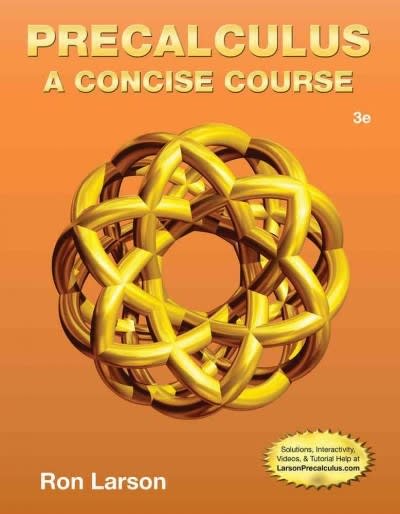Question
The binomial distribution is a frequency distribution that focuses on the possible number of outcomes from a given number of trials that have an equal
The binomial distribution is a frequency distribution that focuses on the possible number of outcomes from a given number of trials that have an equal amount of probability of success (Anderson, Sweeney, Williams, Camm, Cochran, Fry, & Ohlmann, 2020). This probability distribution consists of four properties:
- The trials must be identical - for example, flipping a coin (Anderson, et al., 2020).
- Two outcomes are possible - success or failure (Anderson, et al., 2020).
- The probability of success does not change from one trial to the next. Each trial has the same probability for success (Anderson, et al., 2020).
- The trials are independent of each other - what happens in one trial will not affect the results of the other trial (Anderson, et al., 2020).
Our plumbing company has used the binomial distribution to determine the number of certain projects (residential or commercial) that are of the same size and the number of hours each one took to complete. This helps to provide information regarding how efficient our crews were or if there were problems with the projects outside of our control.
The Poisson distribution shows the probability of a certain number of occurrences of an event over a period of time (Anderson, et al., 2020). This distribution has two properties that must be met:
- The probability of an occurrence is the same for any two intervals of equal length (Anderson, et al., 2020) - for example, finding the probability of the number of leaks in someone's home based on intervals of the length of pipe.
- The occurrence in any interval is independent of an occurrence in another interval (Anderson, et al., 2020) - if one length of pipe has 3 leaks, and another length of pipe has zero leaks they are independent of each other.
Another big difference between the binomial and Poisson distributions is that with the binomial distribution the mean is greater than the variance, while for the Poisson distribution the mean is equal to the variance (Surbhi, 2017).
The journeyman plumbers that work in our company could use the Poisson distribution method to determine if a residential customer would need to replace a section of pipe or consider a repipe of their home based on the number of leaks or defects found in the pipes. Please discuss with reference
Step by Step Solution
There are 3 Steps involved in it
Step: 1

Get Instant Access to Expert-Tailored Solutions
See step-by-step solutions with expert insights and AI powered tools for academic success
Step: 2

Step: 3

Ace Your Homework with AI
Get the answers you need in no time with our AI-driven, step-by-step assistance
Get Started


